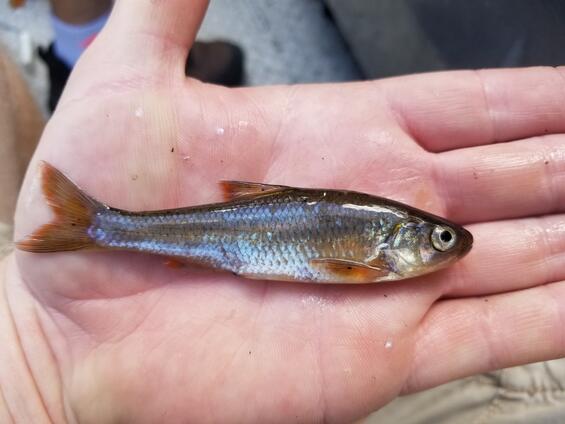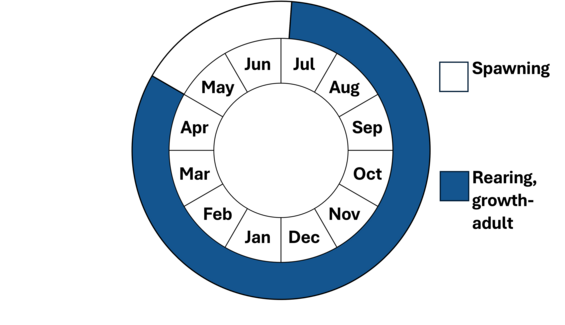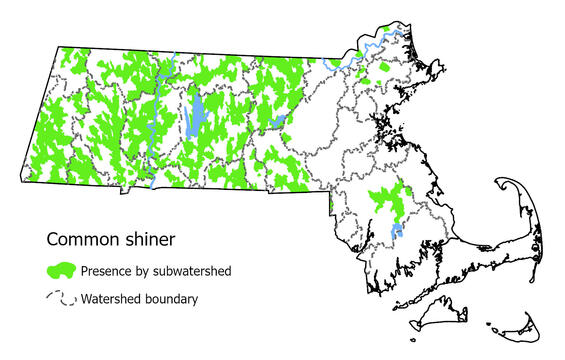- Scientific name: Luxilus cornutus
- Species of Greatest Conservation Need (MA State Wildlife Action Plan)
Description

Non-spawning colors of common shiner collected during a survey on September 15th, 2017.
The common shiner is a relatively deep-bodied minnow with a combination of 9 anal rays (rarely 8 or 10); deeper –than wide anterior lateral scales; and more than five scales above the lateral line. It has horizontal stripes that sometimes can be seen in three bands: a pale mid-dorsal band, a darker stripe below it, and a second pale stripe below that. In breeding males, the stripes become golden and the body bronze; dark crescent-shaped marks appear on the body; the head darkens to blue-gray; and the fins darken with a pink to red distal edge. This species often reaches 5 to 6 inches in length; some Massachusetts specimens reach 7 inches. The common shiner feeds mainly at the surface or in midwater, but it is an opportunistic feeder. Aquatic insects, including both adults and larvae, are the primary food source, but small fishes and some plant materials are also eaten occasionally.
Life cycle and behavior

Common shiners migrate upstream to smaller streams or more suitable sections of rivers to spawn in May. Spawning begins when water temperatures reach 60–65 degrees F. Males are larger than females and defend nests. Common shiners will either construct nests or use nests from other nest-building fishes such as fallfish Semotilus corporalis and creek chubs Semotilis artromaculatus. Sometimes up to 100 common shiners will gather at one nest to compete for position.
Population status
Common shiners can be locally common throughout their range in rivers where they occur — they can tolerate cool to warm streams and rivers. Although populations have not been quantitatively assessed, the species may be impacted by habitat impairments such as dams, pollution, and warming stream temperatures.

Spawning colors displayed during the spawn in this common shiner collected during a survey of the West Branch of the Farmington River (5/25/2018).
Distribution and abundance
In Massachusetts, common shiners are most often found in large rivers to small streams with relatively clean water. In Massachusetts, this minnow is most common from the Connecticut Drainage west, where it is found in all of the major Connecticut River tributaries and in the Hoosic and Housatonic rivers. In addition, there are scattered records from the Nashua, Merrimack, French, Blackstone, Taunton, and Charles River drainages. It is absent from all coastal streams, Cape Cod, and the Islands. The species may be declining.
Common shiners are widespread throughout the Northeast and Upper Mid-West portions of the United States, ranging from Maine to as far south as Virginia and Kansas, and as far west as Colorado and Wyoming.

Data from 1999-2024 from annual surveys.
Habitat
The common shiner is common in many river and stream environments in Massachusetts, but spawning sites are usually over gravel beds in running water.
Healthy habitats are vital for supporting native wildlife and plants. Explore habitats and learn about conservation and restoration in Massachusetts.
Threats
It appears that the common shiner has declined in relative occurrence in the central and eastern portions of the state during the past century. The threats include pollution, dams, stream channel alteration, and altered stream flow.
Conservation
Protecting cool river and stream habitat would likely benefit common shiners.
Survey and monitoring
Common shiners are regularly collected during state fisheries surveys within habitats they occur.
Management
Currently no management plan exists for common shiners.
Research needs
More information on habitat requirements and suitability may be useful in protecting this species.
References
This species description was adapted, with permission, from: Karsten E. Hartel, David B. Halliwell, and Alan E. Launer.
2002. Inland Fishes of Massachusetts. Massachusetts Audubon Society, Lincoln, Massachusetts.
Contact
| Date published: | April 11, 2025 |
|---|